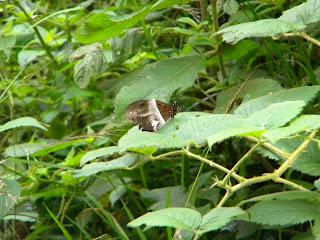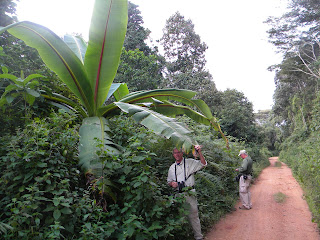The West Usambaras are part of the Eastern Arc Mountains located in southeastern Kenya and northeastern Tanzania. I happened to read a short article yesterday in Living Bird about the Eastern Arc Mountains being a key biodiversity hotspot for conservation priorities. We specifically visited both the West and East Usambara Mountains as part of our mega tour because of the endemics that can be found there. The article pointed out that while these mountains are not on most eco-tours, there are nearly 100 endemic species of birds, mammals, reptiles and amphibians.
We were up at first light which is 6 AM everyday in July since you are on the equator. Similarly, it gets dark by 7 PM everyday. Before breakfast we found red-winged, Waller's, and Kendrick's starlings, white-naped ravens and common fiscal outside our rooms. Breakfast had the usual "suspects"--eggs, sausage, potatoes, toast with butter and jam--but also a very good homemade muesli with yogurt.
It was a largely overcast day--our first of the trip. The weather so far had been surprisingly good with very comfortable temps and humidity. Many people had asked me before leaving on the trip how hot it was going to be. As it turned out, most days were not all that warm, and it was never as bad as the 100 degree, high humidity days that occur regularly in July in Chapel Hill, NC where I live. In the morning and the evening it was often cool enough that a light fleece was needed. The overcast weather had no effect on the silvery cheeked hornbills in the photo above taken by Bob. One of the things we learned early on during the tour was that Brian had alternative names for birds. He called this hornbill saliva cheeked.
There is still a small amount of native forest left in the West and East Usambaras, so we drove a short distance to what had been an old logging road that we could walk slowly up and down looking and listening for birds in the "true forest remnants" that somehow had not ended up being logged. The birding proved to be very difficult because of the thick vegetation, but we did encounter several groups of Angola colubus monkeys during the day.
Since Bob, Stu and I had never birded E. Africa, at the beginning of the trip we were very dependent on Brian to point out what we were looking at, and in the case of forest birding, what we were hearing. Birder friends of mine, who have birded extensively in South and Central America, had told me how frustrating it can be to keep hearing birds singing/calling, but then not be able to see them. This makes having a guide so important because the best of them know the bird songs/calls. Brian has been birding in E. Africa for almost 30 years now, and he knows all the bird songs/calls. Without his help, we would have been largely clueless as to what we were hearing. As the trip went on, we did get a bit better on picking out some bird songs/calls that we heard more regularly, but we never really got very good at it. We did do better on the visuals, but keeping the various names straight was a continual challenge.
As we walked the road we did slowly begin to see some birds either because they finally came out in the open like the bar-throated apalis just above (photo taken by Bob--click on any photo to enlarge), or by playing a tape of a bird's song/call to draw them out into the open. It was much easier to see the many butterflies once it warmed up enough for them to fly about.
There are so many bird families in E. Africa that we do not have in
North America including the bushshrikes which are very colorful like the
black-fronted in the photo just above taken by Bob. We also found Fulleborn's black boobou (photo just below taken by Bob) which is an endemic to the Eastern Arc Mountains.
We did not spend all our time looking up, otherwise we would have missed ground creatures like the 6 inch long centipede that we encountered on several occasions during our trip (photo taken by Bob).
One of the birds we had to work quite hard to get to show itself was the African tailorbird (photo just above taken by Bob). This species is almost endemic to Tanzania, and the long-billed tailorbird is extremely rare and only found in the East Usambaras. Some other new birds on day 4 of our trip that stood out included mountain buzzard and crowned hawk-eagle; olive pigeon; Hartlaub's turaco--one of E. Africa's most colorful bird families; red-rumped swallow, mottled spinetail and black sawwing; cape robin-chat; bar-tailed trogon; mountain wagtail; green barbet and moustached tinkerbird; African dusky flycatcher; yellow-throated wood-warbler; African hill babbler; and African yellow white-eye.
Walking the logging road gave us our first day of dealing with one of E. Africa's family of skulkers--the greenbuls. Bob was moaning throughout the day about how impossible it was to get a photo of a greenbul. We even had a difficult time just getting short glimpses of the Shelley's, eastern mountain, stripe-cheeked, yellow-streaked and placid greenbuls hiding in the foliage. We did finally get identifiable views of another tough bird--the red-faced crimson-wing, but no photo. But Bob did get a photo of the White-tailed crested-flycatcher in the photo just below.
As we were walking back down the logging road towards the end of the afternoon, Brian (in the cap) explained to us that the banana like plant that Bob is holding onto is the source of the many types of bananas now grown throughout E. Africa. We ate some kind of banana every day of our trip--it was one of Bob's favorite snacks.
Another night was enjoyed at the Muller Mountain Lodge where dinner once again was nourishing but nothing to rave about. Tomorrow we make the drive over to the East Usambaras. Stay tuned!
Subscribe to:
Post Comments (Atom)















No comments:
Post a Comment